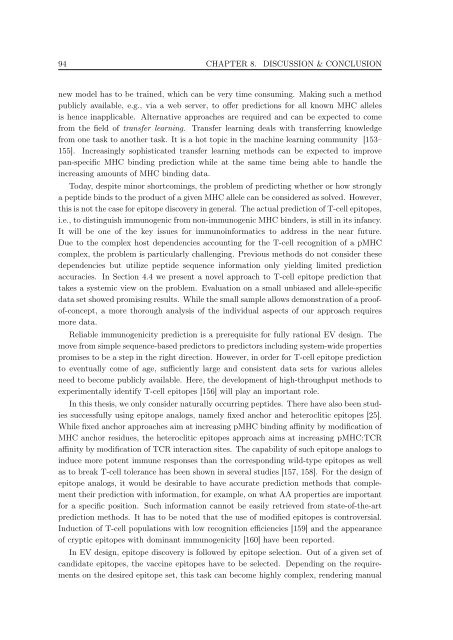New Approaches to in silico Design of Epitope-Based Vaccines
New Approaches to in silico Design of Epitope-Based Vaccines
New Approaches to in silico Design of Epitope-Based Vaccines
Create successful ePaper yourself
Turn your PDF publications into a flip-book with our unique Google optimized e-Paper software.
94 CHAPTER 8. DISCUSSION & CONCLUSION<br />
new model has <strong>to</strong> be tra<strong>in</strong>ed, which can be very time consum<strong>in</strong>g. Mak<strong>in</strong>g such a method<br />
publicly available, e.g., via a web server, <strong>to</strong> <strong>of</strong>fer predictions for all known MHC alleles<br />
is hence <strong>in</strong>applicable. Alternative approaches are required and can be expected <strong>to</strong> come<br />
from the field <strong>of</strong> transfer learn<strong>in</strong>g. Transfer learn<strong>in</strong>g deals with transferr<strong>in</strong>g knowledge<br />
from one task <strong>to</strong> another task. It is a hot <strong>to</strong>pic <strong>in</strong> the mach<strong>in</strong>e learn<strong>in</strong>g community [153–<br />
155]. Increas<strong>in</strong>gly sophisticated transfer learn<strong>in</strong>g methods can be expected <strong>to</strong> improve<br />
pan-specific MHC b<strong>in</strong>d<strong>in</strong>g prediction while at the same time be<strong>in</strong>g able <strong>to</strong> handle the<br />
<strong>in</strong>creas<strong>in</strong>g amounts <strong>of</strong> MHC b<strong>in</strong>d<strong>in</strong>g data.<br />
Today, despite m<strong>in</strong>or shortcom<strong>in</strong>gs, the problem <strong>of</strong> predict<strong>in</strong>g whether or how strongly<br />
a peptide b<strong>in</strong>ds <strong>to</strong> the product <strong>of</strong> a given MHC allele can be considered as solved. However,<br />
this is not the case for epi<strong>to</strong>pe discovery <strong>in</strong> general. The actual prediction <strong>of</strong> T-cell epi<strong>to</strong>pes,<br />
i.e., <strong>to</strong> dist<strong>in</strong>guish immunogenic from non-immunogenic MHC b<strong>in</strong>ders, is still <strong>in</strong> its <strong>in</strong>fancy.<br />
It will be one <strong>of</strong> the key issues for immuno<strong>in</strong>formatics <strong>to</strong> address <strong>in</strong> the near future.<br />
Due <strong>to</strong> the complex host dependencies account<strong>in</strong>g for the T-cell recognition <strong>of</strong> a pMHC<br />
complex, the problem is particularly challeng<strong>in</strong>g. Previous methods do not consider these<br />
dependencies but utilize peptide sequence <strong>in</strong>formation only yield<strong>in</strong>g limited prediction<br />
accuracies. In Section 4.4 we present a novel approach <strong>to</strong> T-cell epi<strong>to</strong>pe prediction that<br />
takes a systemic view on the problem. Evaluation on a small unbiased and allele-specific<br />
data set showed promis<strong>in</strong>g results. While the small sample allows demonstration <strong>of</strong> a pro<strong>of</strong><strong>of</strong>-concept,<br />
a more thorough analysis <strong>of</strong> the <strong>in</strong>dividual aspects <strong>of</strong> our approach requires<br />
more data.<br />
Reliable immunogenicity prediction is a prerequisite for fully rational EV design. The<br />
move from simple sequence-based predic<strong>to</strong>rs <strong>to</strong> predic<strong>to</strong>rs <strong>in</strong>clud<strong>in</strong>g system-wide properties<br />
promises <strong>to</strong> be a step <strong>in</strong> the right direction. However, <strong>in</strong> order for T-cell epi<strong>to</strong>pe prediction<br />
<strong>to</strong> eventually come <strong>of</strong> age, sufficiently large and consistent data sets for various alleles<br />
need <strong>to</strong> become publicly available. Here, the development <strong>of</strong> high-throughput methods <strong>to</strong><br />
experimentally identify T-cell epi<strong>to</strong>pes [156] will play an important role.<br />
In this thesis, we only consider naturally occurr<strong>in</strong>g peptides. There have also been studies<br />
successfully us<strong>in</strong>g epi<strong>to</strong>pe analogs, namely fixed anchor and heteroclitic epi<strong>to</strong>pes [25].<br />
While fixed anchor approaches aim at <strong>in</strong>creas<strong>in</strong>g pMHC b<strong>in</strong>d<strong>in</strong>g aff<strong>in</strong>ity by modification <strong>of</strong><br />
MHC anchor residues, the heteroclitic epi<strong>to</strong>pes approach aims at <strong>in</strong>creas<strong>in</strong>g pMHC:TCR<br />
aff<strong>in</strong>ity by modification <strong>of</strong> TCR <strong>in</strong>teraction sites. The capability <strong>of</strong> such epi<strong>to</strong>pe analogs <strong>to</strong><br />
<strong>in</strong>duce more potent immune responses than the correspond<strong>in</strong>g wild-type epi<strong>to</strong>pes as well<br />
as <strong>to</strong> break T-cell <strong>to</strong>lerance has been shown <strong>in</strong> several studies [157, 158]. For the design <strong>of</strong><br />
epi<strong>to</strong>pe analogs, it would be desirable <strong>to</strong> have accurate prediction methods that complement<br />
their prediction with <strong>in</strong>formation, for example, on what AA properties are important<br />
for a specific position. Such <strong>in</strong>formation cannot be easily retrieved from state-<strong>of</strong>-the-art<br />
prediction methods. It has <strong>to</strong> be noted that the use <strong>of</strong> modified epi<strong>to</strong>pes is controversial.<br />
Induction <strong>of</strong> T-cell populations with low recognition efficiencies [159] and the appearance<br />
<strong>of</strong> cryptic epi<strong>to</strong>pes with dom<strong>in</strong>ant immunogenicity [160] have been reported.<br />
In EV design, epi<strong>to</strong>pe discovery is followed by epi<strong>to</strong>pe selection. Out <strong>of</strong> a given set <strong>of</strong><br />
candidate epi<strong>to</strong>pes, the vacc<strong>in</strong>e epi<strong>to</strong>pes have <strong>to</strong> be selected. Depend<strong>in</strong>g on the requirements<br />
on the desired epi<strong>to</strong>pe set, this task can become highly complex, render<strong>in</strong>g manual

















